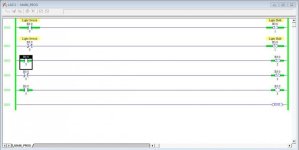arnabbanik
Member
Hi All,
thanks for such a wonderful forum. I am a beginner and I was playing around with instructions. I just randomly built the attached logic.
My questions is :-
On rung 3, if I am toggling the left switch, why is it not allowing me to latch on the right side?Shouldn't it be true, as if left is true, it should be true on the right?
If anyone can give me an insight, I will highly appreciate.
Thanks,
Arnab
thanks for such a wonderful forum. I am a beginner and I was playing around with instructions. I just randomly built the attached logic.
My questions is :-
On rung 3, if I am toggling the left switch, why is it not allowing me to latch on the right side?Shouldn't it be true, as if left is true, it should be true on the right?
If anyone can give me an insight, I will highly appreciate.
Thanks,
Arnab





